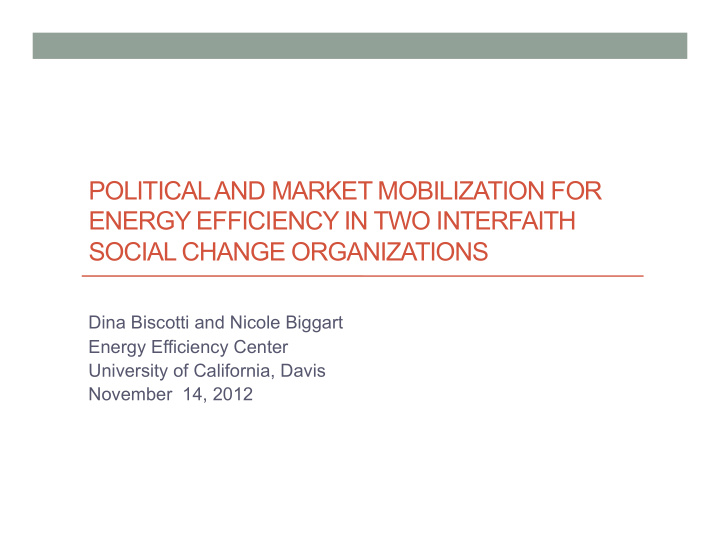



POLITICAL AND MARKET MOBILIZATION FOR ENERGY EFFICIENCY IN TWO INTERFAITH SOCIAL CHANGE ORGANIZATIONS Dina Biscotti and Nicole Biggart Energy Efficiency Center University of California, Davis November 14, 2012
Faith communities in action
Outline • Assess the dominant thinking behind mainstream energy efficiency programs • Explore alternative rationales for social action and social change • Examine efforts to diffuse energy efficiency and renewables in faith-based organizations • Assess how networked social change organizations foster change within institutional settings
Beyond the self-interested, utility-maximizing individual and the psychological subject responding to peer pressure Neoclassical economics Social psychology Rebates and incentives Detailed (but anonymous) utility bills comparing your energy usage with that of Emphasizes cost-savings your neighbors associated with energy efficiency technology adoption and behavior change
Systems of Exchange Typology Biggart and Delbridge, 2004, Academy of Management Review , 29: 28-49.
Direct Selling Organizations: Leveraging Social Relationships Biggart, 1989
Interfaith Power and Light: A Religious Response to Global Warming “O” Magazine, July 2010
GreenFaith: Leadership and Certification Programs
4 th Annual CIPL Energy Oscars—2010
5 th Annual CIPL Energy Oscars—2011
Direct Selling? Great holiday gifts from Interfaith Power & Light Energy efficient LED holiday lights Instant Discounts Available for Faith Organizations through This Online Store
More energy efficiency-related products available on the IPL website Ceiling fans Window air sealing Chimney Air Sealing Refrigerator thermometer Water heater blanket Smart Powerstrips Caulk
Local decision-making in congregation renovation project • Protestant congregation in a progressive, affluent and educated community • Member of CIPL—but not highly active in the organization • Has a green team • Faith leader preaches about ecology and faith • About 200 active members • Capital campaign for renovation project raised $1 million in pledges
Local decision-making in congregation renovation project • Early priority-setting meeting—potluck lunch, 65 members in attendance • Worked with a consultant on decision- making processes • “We will try to be green as much as we can, that’s kind of our given. Our goal is to exceed the city standard for greening as much as we can . . .There are many levels to green.” (congregation president)
Mission priorities • Worship and Music 23% 30% • Welcoming and Hospitality 30% • Fellowship, Community and Education • Communication, Administration & 8% Staff • Super green 9% • “If you’re ‘Kermit the Frog’ green. If you want us to be the gold standard for our city with LEED certification, high energy efficiency, etc.”
Recipes for Action: Reducing Uncertainty
Increasing Motivation: Commitments and Goal-Setting
Faith leaders and social change
Political Mobilization AB32: California Global Warming Solutions Act
Take Action! Tell Your Senators: be a Climate Convert! “Religious leaders representing a wide spectrum of faiths and regions across California announced they are joining forces to defeat Proposition 23 , the November ballot initiative that aims to overturn California clean air and clean energy law.” “As a person of faith with a strong concern that global warming disproportionately affects the poor and vulnerable in our country and abroad, I urge you to oppose all riders to the FY11 Interior Appropriations bill that block or delay enforcement of the Clean Air Act . . . . . . . . . . I believe we all have a moral responsibility to protect Creation and to protect our neighbors.”
A growing social movement
Growing partnerships between secular environmental and religious organizations Moral Call to Action on Climate
“For the Love of God: Caring for Creation”
Conclusion • Multiple logics inform human action • People are socialized within institutions • Social relationships and social institutions can be leveraged to drive behavior change • Social change organizations that create recipes for action and foster mutual awareness of organizations within a field can help accelerate institutional change
Recommend
More recommend